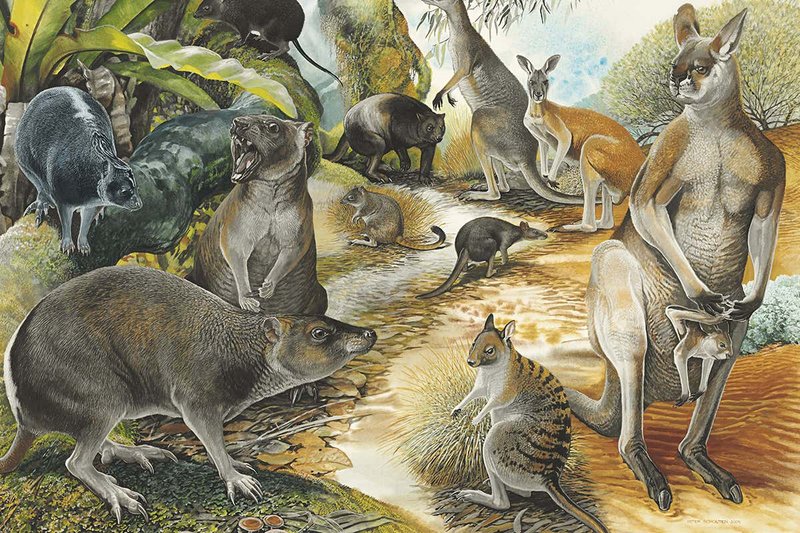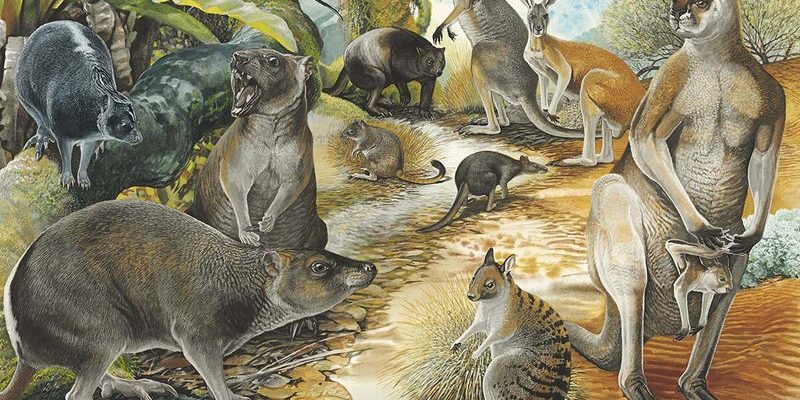
In this exploration, we’ll hop through time, discussing the various ancestors of kangaroos, how they adapted to their environments, and what makes them so special. So grab a cup of coffee, sit back, and let’s jump into the evolutionary journey of the kangaroo!
The Origins of Kangaroos
The story of kangaroos begins about 70 million years ago, during the Late Cretaceous period. At that time, Australia was part of the supercontinent Gondwana, which also included South America, Africa, and Antarctica. This unique geographical setup meant that kangaroos evolved in a relatively isolated environment, leading to distinctive species that adapted to different habitats.
Kangaroos belong to a group of marsupials called Macropodidae, which translates to “big foot.” This family includes not only kangaroos but also wallabies, tree kangaroos, and other relatives. The earliest known ancestors of kangaroos were small and resembled their modern relatives, but they were still quite different. They likely complemented their diets with both vegetation and small insects, showcasing their adaptability.
If you picture a timeline stretching back millions of years, you’d notice these early marsupials started to diversify as climate and environmental conditions changed. Some settled in lush forests, while others thrived in open grasslands. This adaptability allowed them to exploit various food sources, setting the stage for the evolution of different kangaroo species.
Adaptations Over Time
As the prehistoric world changed, so did the ancestors of kangaroos. One of the most notable adaptations was the development of their powerful hind legs. You might be wondering, why hopping? Well, it turns out that hopping is an energy-efficient way to travel long distances, especially in the vast, arid landscapes of Australia.
Kangaroos developed a unique musculoskeletal system that supports this movement. Their long, strong legs allow them to cover significant ground while conserving energy. Think of it like driving a car with excellent fuel efficiency—you can go farther for less. This ability to travel long distances in search of food and water proved crucial for survival.
Additionally, kangaroos have adapted to their herbivorous diet in interesting ways. Their digestive systems are specifically designed to break down tough plant materials. They have complex stomachs, similar to those of cows, which allow them to ferment food and extract maximum nutrients. These adaptations help them thrive in environments where food can be scarce, especially during dry seasons.
The Role of Climate Change
Climate plays a significant role in the evolutionary history of kangaroos. Over the past several million years, Australia has experienced fluctuating climates, ranging from tropical forests to arid deserts. Each shift created new challenges and opportunities for the kangaroo population.
During periods of drought, for instance, many species faced food shortages, driving natural selection. The kangaroos that could travel longer distances and find food sources more efficiently were more likely to survive and reproduce. This ongoing process shaped the species we see today, helping them adapt their behaviors and physical traits to their ever-changing environment.
Interestingly, the ancient relatives of kangaroos faced their own climate challenges. Some ancient species, like the Diprotodon—an enormous, wombat-like creature—thrived during wetter conditions but ultimately went extinct as climates dried out. This highlights how sensitive species can be to climate changes, posing a constant challenge for survival.
Evolution of Different Species
Today, there are over 60 species of kangaroos and their relatives, each adapted to specific environments. The most well-known species is the Red Kangaroo, which can be found across the Australian interior. It is the largest living marsupial, and its size and strength make it an iconic representation of Australia.
Other species, like the Eastern Grey Kangaroo, prefer the lush pastures of the eastern states. Their adaptations to different habitats showcase the incredible versatility within the kangaroo family. Some species have even developed social structures, living in groups called mobs. This social behavior helps them protect one another and find food more effectively.
While each species shares common traits, their differences highlight the impact of their unique environments and evolutionary pressures. Some species have longer legs for better hopping in open plains, while others have stout bodies for climbing in forests or maneuvering through dense vegetation. These adaptations reveal the fascinating ways evolution shapes biodiversity.
The Unique Features of Kangaroos
Kangaroos are not just remarkable for their hopping abilities; they have several unique features that make them stand out. For starters, their pouch is a defining characteristic of marsupials. Female kangaroos carry their young in this pouch for several months, allowing the vulnerable joeys to develop safely.
The pouch offers warmth and protection, but it’s also a fascinating evolutionary trait. While other mammals may carry their young in different ways, the pouch allows for an extended period of breastfeeding and bonding. This close relationship enhances the offspring’s chances of survival in the wild.
Another intriguing feature is their ability to regulate body temperature. Kangaroos use a method called thermal windows—areas on their bodies that help release heat. In hot climates, they often lick their forearms to cool down, making them adept at managing their body temperatures in harsh environments. This ability to adapt to varying climates is crucial for their survival.
Current Threats and Conservation Efforts
Despite their evolutionary success, kangaroos face modern challenges. Habitat loss due to urbanization, agriculture, and climate change threatens their populations. Once thriving regions are shrinking, forcing kangaroos into smaller spaces, which can lead to conflict with humans.
Conservation efforts are underway to protect kangaroo habitats and populations. Organizations are working to restore ecosystems and create wildlife corridors that allow kangaroos to navigate safely between fragmented habitats. In some areas, controlled culling is implemented to manage populations that have grown too large for the available food resources.
Here’s the thing: kangaroos play a vital role in their ecosystems. They help graze on grasses, promote plant growth, and provide food for predators. Protecting them isn’t just about saving a species; it’s about maintaining the balance of their ecosystem.
The Future of Kangaroos
Looking ahead, the future of kangaroos largely depends on how we respond to environmental changes. With climate change continuing to impact habitats, scientists emphasize the need for sustainable practices and conservation efforts. Public awareness plays a crucial role in these initiatives, and education about kangaroos can encourage responsible behaviors.
Researchers are also studying kangaroo genomics, which holds potential for understanding how they adapt to climate changes. Discoveries about their genetics may help inform conservation strategies and ensure the survival of these incredible creatures.
As we reflect on the evolutionary history of the kangaroo, it’s clear that these animals have been shaped by millions of years of adaptation and environmental challenges. By prioritizing their protection and understanding their needs, we can help ensure that kangaroos continue to thrive for generations to come.
In conclusion, the evolutionary history of the kangaroo is a remarkable tale of survival, adaptation, and resilience. From their ancient ancestors to their various modern-day species, they showcase nature’s incredible ability to evolve and thrive. By appreciating their journey, we can better support their future in the wild.

